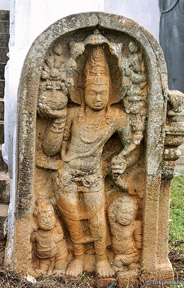Archeological guardstone sculptures
Subashini Pathmanathan
Sri Lanka has a variety of archeological sculptures which is well
scattered. It provides a wealth of information for the development of
Bharatha Natyam. But nobody uses these sources for studies in Sri Lanka.
Sri Lankan structural architecture pattern buildings, Hindu temple
structure, cultural chambers, sculpture and paintings resemble South
Indian temples. Despite the similarities Sri Lanka preserves its own
identity.
Archeological sites of Sri Lanka play an important role. These
archeological sites were not built for general purposes. They were
considered as community development centres.
 |
|
Guardstone |
The construction of worshipping places has their patterns and plans,
which resembles their own culture, customs, regional and religious
influences of different periods. Besides, construction patterns of each
worshipping place of each region provides an ample evidence of the
rulerís taste. He, who built the temple with their own involvement of
art, culture, tradition and religion.
Ancient Indian rulers were deeply involved with culture and
traditions. Different rulers built temples and cultural chambers
throughout the Indian sub continent. That also influenced the
neighbouring Sri Lanka. In Sri Lanka each temple architecture and
sculptures constructed during different periods, reveal different style,
different social and different cultural influences.
The outstanding facts, which could be easily noticeable, reveal that
most generally archeological sculptures are divided into different
categories. Some are stone-made sculptures. Some are metal sculptures
including copper, gold, silver and five different mixed metal sculptures
(iympon) statues. These sculptures last long. Yet these longstanding
metal sculptures do not last like the ancient temple sculptures which
are made out of grenade.
Archeological sites
In the Hindu temple structures, at the entrance the two guards are
always installed. The male guards are often called as Duvalapalakars. In
the female Kali temples the female guards guarding the temples are often
called as Duvalapalakis. These guards are always in a standing position.
Meanwhile one leg is bended and one hand is holding kathautham. And the
other leg is always rested on the floor. This particular pose is always
adopted in the Classical Bharatha Natyam to depict numerous poses of
different deities while dancing.
Similarly in the Sri Lankan archeological sites, also at the
entrances beautiful and different reasons numerous guard stones were
installed. The main and ultimate reason is to install these guard stones
at the entrance of the important places such as temples (Buddhist
temples). Earlier the guard stones were installed at, ancient royal
palaces, ancient important royal courts, water reservoirs, water tanks
and cultural chambers. In Sri Lanka a variety of guard stones are found
at different archeological sites. These guard stones are in standing
postures with curved body positions, and with different foot positions.
All these resemble the classical Bharatha Natyam stand poses and
postures. In the technical terms the stands of Bharatha Natyam and body
positions are often referred to as Mandala Isthana positions.
The hood of the guard stones is more often shaded with multi-headed
cobras. This particular variety of Guard stones were often found at the
entrances of the water reservoirs, and at the entrance of the royal
palaces, and the places where the treasures were buried.
Beautiful ornaments
This multi headed Naga king is called Naga Raja. And in Tamil it is
as Raja Nagam. Raja Nagam has a special place in Hinduism. The Raja
Nagam worship is called in Hinduism as Naga Thampiran worship.
Some Raja Nagams of guard stone are portrayed with five heads, some
have seven heads, and some are portrayed with nine heads. To depict the
Raja Nagam in Bharatha Natyam the Muthura (Hastha) Sarpa sirasa is used.
These guards stones are highly decorated with beautiful ornaments,
layer and layer of waist chains, the costumes of the guard stones
resemble the beautiful Bharatha Natyam costumes. Besides, beautiful ear
ornaments, chest ornaments, highly crafted head crowns are worn by these
sculptures, which almost resemble the close affinity of the Hindu temple
sculptures and the Hindu temple tower sculptures.
In one hand of the guard stone is carrying punkalasa (a pot), and the
other hand is holding a branch of buds, and flowers. In Bharatha Natyam
by depicting such hand gestures through abinaya are quite common. Some
guard stones only have Naga Raja guard stones.
With the passage of time with the Naga Raja gurd stones was Bahirawa
were added. Bahirawa were added to protect the wealth. Sankha and padma
the two ganas (Yakas) were installed at the feet of Naga Raja.
Beautiful Naga Raja stones could be founded in Anuradhapura and
polannaruwa.
Heads of the Naga Raja were well decorated with exclusive beautiful
ornaments. Over some guard stones Makara head were installed, at the
base of the arch lion and dancing human figures were depicted. These
imply the close links of dance with Sri Lankan archeological guard
sculptures.
|



